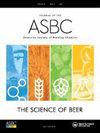Use of Yeasts in Traditional Alcoholic Beverages in Tanzania and Potential Opportunities
IF 1.8
4区 农林科学
Q4 BIOTECHNOLOGY & APPLIED MICROBIOLOGY
Journal of the American Society of Brewing Chemists
Pub Date : 2022-02-15
DOI:10.1080/03610470.2021.2013677
引用次数: 2
Abstract
Abstract Alcoholic beverages are produced in many parts of the world for different purposes, including refreshment and people’s cultural and religious practices. The advancement in their production technology has evolved over time due to a number of factors, including the availability of modern equipment, innovation, operating costs, and customer competition. In Africa, particularly Tanzania, different types of traditional beverages are produced. These beverages have been recognized for their contribution to households’ economy, especially in rural and semi-urban areas. However, limited strategic measures have been implemented to realize their potential in local and international markets. Among the major concerns under this category is the source and management of fermentation cultures in use, which affect the quality, safety, consistency, and shelf life of the final products. Fermentation is the basis of almost all alcoholic beverages. It involves the use of fermenting cultures containing a mixture of microorganisms, often yeast, lactic acid bacteria, and molds. The sources of these traditional fermenting cultures are mainly a fermented porridge of cereals and banana juice, a portion of a previous brew, or dried yeast harvested from a previous brew. This review discusses the potential of the use of culture yeast in adding value to traditional alcoholic beverages, especially in terms of quality and shelf life. Yeast selection, yeast management, waste yeast management, and the role of quality assurance in yeast management are covered.酵母在坦桑尼亚传统酒精饮料中的使用及其潜在机遇
世界上许多地方都生产酒精饮料,用于不同的目的,包括提神和人们的文化和宗教习俗。由于许多因素,包括现代设备的可用性,创新,运营成本和客户竞争,他们的生产技术的进步随着时间的推移而发展。在非洲,特别是坦桑尼亚,生产不同类型的传统饮料。这些饮料因其对家庭经济的贡献而得到认可,特别是在农村和半城市地区。但是,为发挥它们在当地和国际市场上的潜力而采取的战略措施有限。这一类别下的主要问题是使用中的发酵培养物的来源和管理,这影响最终产品的质量、安全性、一致性和保质期。发酵是几乎所有酒精饮料的基础。它包括使用含有微生物混合物的发酵培养物,通常是酵母、乳酸菌和霉菌。这些传统发酵文化的来源主要是谷物和香蕉汁的发酵粥,以前酿造的一部分,或者从以前酿造的酿造中收获的干酵母。本文讨论了利用培养酵母增加传统酒精饮料附加值的潜力,特别是在质量和保质期方面。酵母的选择,酵母管理,废酵母管理,以及酵母管理质量保证的作用。
本文章由计算机程序翻译,如有差异,请以英文原文为准。
求助全文
约1分钟内获得全文
求助全文
来源期刊

Journal of the American Society of Brewing Chemists
工程技术-生物工程与应用微生物
CiteScore
4.00
自引率
20.00%
发文量
41
审稿时长
3 months
期刊介绍:
The Journal of the American Society of Brewing Chemists publishes scientific papers, review articles, and technical reports pertaining to the chemistry, microbiology, and technology of brewing and distilling, as well as the analytical techniques used in the malting, brewing, and distilling industries.
 求助内容:
求助内容: 应助结果提醒方式:
应助结果提醒方式:


